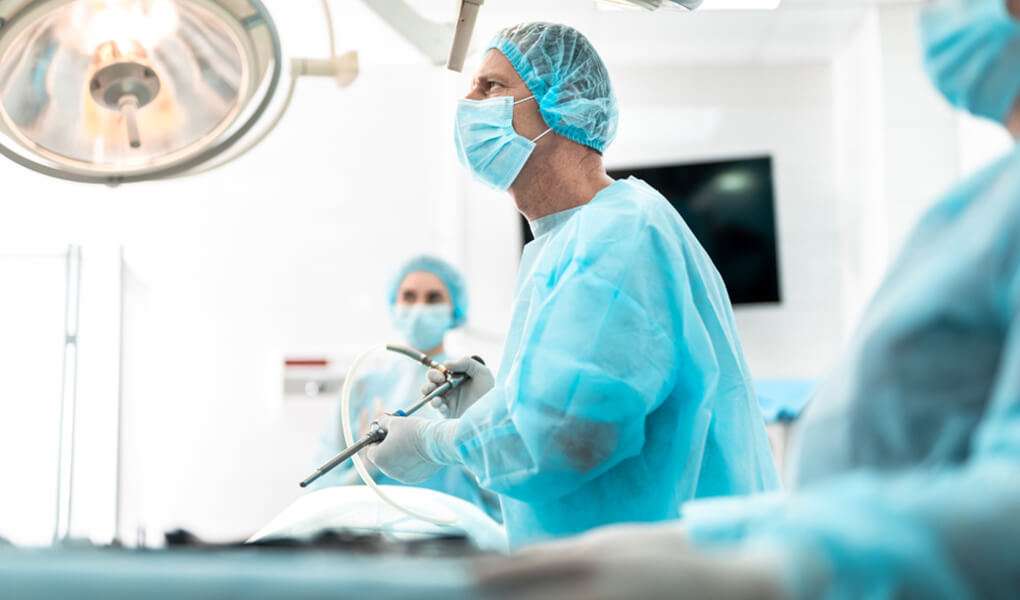Follow Us!
Patient stories, informative videos and much more on our social media accounts

Laparoscopy, commonly known as bloodless or closed surgery, is a diagnostic and treatment method that allows patients to experience less pain and heal more quickly compared to open surgery.
Thanks to specialized equipment used during laparoscopy surgery, the necessary incision area is between 0.5 and 1 cm. Besides the aesthetic advantage of a smaller scar, tissue and organ adhesions that often develop after open surgery are minimal following laparoscopy.
Patients also experience less postoperative pain and recover faster, allowing them to return to their daily lives sooner.
For this reason, laparoscopy is considered the gold standard among surgical methods. Before gaining detailed knowledge about laparoscopy surgery, it’s essential to understand what laparoscopy is.
What is Laparoscopy?
The simplest answer to the question “What is laparoscopy?” is that it is a medical diagnostic and treatment method performed with the aid of optical devices.
Initially, laparoscopy was used for diagnostic purposes, but with technological advancements, it is now also used for treatment (laparoscopic surgery).
Compared to traditional surgical methods, recovery after laparoscopy is remarkably quick due to the small incisions made in the abdominal area. The laparoscope, or optical device, is inserted through an incision in the abdomen, allowing the surgeon to observe the area on a monitor.
If intervention is needed, trocars (small tubes) are inserted through incisions in the abdomen, allowing the introduction of instruments to the surgical site, enabling the surgeon to operate effectively.
Multiple procedures can be performed through the abdominal and lower abdominal areas. Although smaller incisions are required compared to open surgery, this method provides a broader view, with fewer complications such as infection, adhesions, and hernia.
Patients recover and return to normal life much faster after laparoscopy.
Regardless of the extent of the procedure, pain experienced by the patient is considerably less than in open surgery, leading to quicker recovery with less medication. Laparoscopic surgery, performed through 3 or 4 incisions, carries far fewer risks compared to traditional methods.
Therefore, this method, defined as the gold standard, is used to treat many conditions, especially gynecological disorders.
In Which Cases is Laparoscopy Applied?
How is Laparoscopy Performed?
The procedure begins with an initial incision made below the navel. Carbon dioxide, a colorless and odorless gas, is introduced into the abdomen through a needle called a Veress needle, inflating the abdominal cavity for better visibility of internal organs. The bloating felt in the abdomen post-laparoscopy is due to this gas, which naturally exits the body after surgery.
Once the abdomen is inflated with carbon dioxide to a suitable level, a trocar tube is inserted through the incision, and an optical device (laparoscope) is placed inside, establishing visual contact with the relevant area. Two or three additional incisions of 0.5 cm in diameter are made, and trocars are inserted in these areas.
Through these openings, specialized instruments used in laparoscopic surgery are inserted into the abdomen. After completing the procedure, all instruments and trocars are removed, the carbon dioxide is released, and the incision sites are sutured and closed.
Why is Laparoscopic Surgery Done?
Used frequently in gynecology and many surgical fields, laparoscopy is often utilized to investigate infertility-related causes and detect or treat issues in the abdominal cavity or fallopian tubes that may hinder pregnancy.
Ectopic pregnancies, cysts, and fibroids can also be diagnosed and treated laparoscopically. Laparoscopy is commonly used for uterine surgeries, including total hysterectomy (removal of the uterus), sacrocolpopexy (for uterine prolapse), and surgeries for uterine cancer.
The laparoscopic method is also used for ovarian cyst removal (cystectomy), oophorectomy (removal of ovaries), tubal ligation or repair, and other pelvic issues.
Laparoscopy, often referred to as minimally invasive surgery, is chosen over open surgery due to its comfort, reduced infection risk, and advantages for both the patient and surgeon.
Preoperative Instructions for Laparoscopy
Your doctor will inform you about the preparations required before laparoscopy. Like traditional surgery, patients undergoing laparoscopy are put under general anesthesia, so it’s essential to abstain from food and liquids for at least six hours prior to surgery.
How Long Does Laparoscopic Surgery Take?
While diagnostic laparoscopy typically lasts about 20-30 minutes, anesthesia administration and awakening add about 40-45 minutes. Laparoscopic surgeries for treatment vary depending on the area of intervention and the nature of the condition.
Main Advantages of Laparoscopy:
Does Laparoscopy Increase the Success of IVF?
Laparoscopy can enhance the success of IVF treatments. If the patient has high-quality embryos, it is essential to assess the condition of the tubes before the transfer. Hydrosalpinx, fluid-filled tubes, not only hinder natural pregnancy but also lower the success rate of IVF.
In cases where fluid accumulation occurs in the tubes, they can be removed or disconnected from the uterus through laparoscopy.
By treating fibroids within the uterine walls and chocolate cysts (endometriomas) in the ovaries with laparoscopy, the chances of pregnancy can be increased.
Postoperative Recovery after Laparoscopic Surgery
After the procedure, the patient is brought to their room. They may experience mild nausea until the effects of anesthesia wear off and slight pain at the incision site, which is normal.
Depending on the type of procedure, most patients can stand up within 3 to 4 hours and have a light meal. Due to the carbon dioxide gas used to expand the abdominal cavity, mild shoulder pain may be felt for about 24 hours post-surgery.
Let us call you as soon as possible regarding the issues you want to consult.


